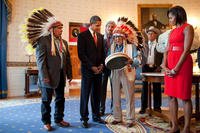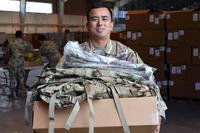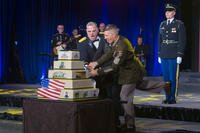The Army Reserve of today can trace its roots as a national Citizen-Soldier force as far back as the French and Indian War (1756-1763) on through the Civil War (1861-1865) to the Spanish-American War and Philippine Insurrection (1898-1902). From its birth in 1776 through the nineteenth century, the United States remained a regional power, protected from invasion by the vast expanses of the Atlantic and Pacific oceans. A large standing army was not required, and the nation's defense was based primarily on the militias of individual states.
The United States Congress created an official Army Reserve in order to place a large portion of American Citizen-Soldiers under federal control during times of peace and war. Financially, this was the best option for maintaining and projecting a land force that rivaled those of other world powers. This decision came into play during World War I (1917-1919) when the Army mobilized nearly 90,000 Reserve officers, one-third of which were medical doctors. More than 80,000 enlisted Army Reserve Soldiers served. The individual Army Reserve Soldiers were placed into newly organized units, trained, and then deployed.
Between World War I and World War II, the Army planned for an Organized Reserve force of thirty-three divisions. When the United States entered the Second World War in December 1941, the number of Army Reserve officers on active duty rose from less than 3,000 to more than 57,000. World War II signified the beginning of a new era in national security, and from that point on the United States became the "arsenal of democracy" and "world guardian," a new mission in which the Army Reserve would play a major role. To defray the cost of maintaining such a large military force, Congress relied heavily on establishing and sustaining a more combat ready Army Reserve meant to deploy with the Active Army worldwide.
Recognizing the importance of the Organized Reserve to American success during World War II, Congress authorized retirement and drill pay for the first time in 1948. The Korean War (1950-1953) saw more than 240,000 Army Reserve Soldiers called to active duty. That large number reflected the Army's need for organized, trained personnel in a short period of time. While the Korean Conflict was still underway, Congress began making significant changes in the structure and role of the Army Reserve. These changes transformed the Organized Reserve Corps into the United States Army Reserve (USAR). This new organization was divided into a Ready Reserve, Standby Reserve, and Retired Reserve.
Throughout the entire Cold War period, after the Korean War, the Army Reserve was mobilized only twice; over 68,500 Army Reserve Soldiers for the Berlin Crisis (1961-1962) and nearly 6,000 for the Vietnam War during the period from 1968 to 1969. In reality, it existed as a strategic reserve and the Active Army handled most military operations without reserve components. This would all change with the end of the Cold War and the further draw-down of the Active Army in the 1990s.
Faced with implementing a global peacekeeping mission with a greatly curtailed military budget and active military force, Congress intended to use the reserve components to make up for the loss of personnel. This required the Army Reserve to be manned, equipped, and trained at levels comparable to the Active Army. It was from this concept that the Army Reserve "Operational Reserve" would evolve over the next twenty years.
To improve the combat readiness of Army Reserve units, Congress mandated the creation of the United States Army Reserve Command (USARC) in October 1990 which provided more centralized management. In addition, a major post-Cold War effort to restructure the Army's reserve components culminated with the 1993 "Offsite Agreement." This compromise stabilized force structure and end-strength reductions so the Army could place more reliance on reserve components for military operations.
The agreement led to the National Guard specializing in combat arms and divisional level combat support and service support, while the Army Reserve specialized in combat support and service support at corps levels and above. This enabled the Active Army to maintain higher levels of combat arms troops. This change in mission was typified by amendments made in the 1990s for the Armed Forces Reserve Medal, which authorized its award for mobilization and later added an "M" Mobilization Device and numbers for each different contingency operation a Reserve Soldier was called-up to serve.
Since then, more than ten years of persistent conflict and continual rotation of Army forces required changes in the way the Army fought and generated forces. The size of the active Army proved insufficient to the demand. Accordingly, both the United States Army Reserve and the Army National Guard were routinely called upon to satisfy personnel requirements both locally and globally, but primarily in Iraq and Afghanistan. As a result of increased resources for training and the experience accrued during multiple combat rotations, the Army Reserve achieved unprecedented levels of readiness which led to it being dubbed an "operational force."
Not willing to sacrifice the decade long investment in this Army Reserve reformation, the nation now calls upon Army Reserve Soldiers to expect mobilization as a probability, not a possibility. Business as usual, one weekend a month and two weeks in the summer is anachronistic and represents the "old
legacy" strategic reserve, not the evolving operational, "expeditionary" Army Reserve. Since, 9/11 over 200,000 Army Reserve Soldiers have been activated in the Global War on Terrorism (GWOT). Today, almost 150,000 Army Reserve Soldiers serve in over 1600 units progressing through the Army's five year rotational ARFORGEN model.
Quite simply, the nation cannot go to war without the critical capabilities resident in the Army Reserve. Accordingly, victory can only be attained with a totally integrated, three component (active Army, Army National Guard, Army Reserve) expeditionary force capable of persistent decisive action together with the other branches of the armed forces. Army Reserve Warrior Citizens have been tested in the crucible of combat, earning their status as full partners in those operations; no longer a supplemental, strategic reserve force but rather an able and operational force upon whom the Nation must routinely call.













